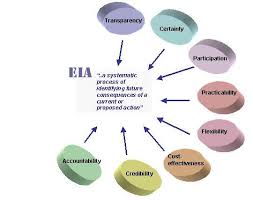What is an EIA?
Environmental Impact Assessment (EIA) is a tool used in most environment based organisations to measure the impact of the environment through the assessment tool. It measures the environmental consequences of a particular plan or policy. This could be important for Urban Planning and Development policies because many of these policies are centered on the environment. It supports development projects for people who assess and analyse the environmental projects.
EIA does not only involve environment but also considers social, cultural and health impacts on the environment. For instance, climate change can be used as an example where EIA could be a useful tool to measure the impact of the environment on climate issues. EIA is usually used prior to making a final decision by experts, giving the people of authority a detailed plan of the positives and negatives of the EIA. Environmental assessments can be monitored by administrations and large companies prior to considering Strategic Environmental Assessment (SEA).
Related: Strategic Environmental Assessment (SEA)
Benefits of EIA
There are many benefits to conducting an EIA. Many government and donor agencies make use of EIA to understand and implement complex environmental issues, such as waste management or water management techniques. Some countries have specific legal and institutional regulations before conducting an EIA. An EIA is a part of Resource Management Acts in many countries who are particularly interested in preserving and maintaining their environment such as Canada and Australia.

Some general benefits of an EIA include cost saving and reduced time of project implementation and adhering of legal regulations. EIA is economically feasible because it takes relatively minimal time compared to other environment assessment techniques which might not be precise and might not be advantageous to the organisation. Another benefit of EIA is that it if it is followed according to the methods involved, it can be used to protect the forestry, trees, water, waste, agriculture, recreational and cleanliness of cities. These are very important benefits for positive and vibrant city planning.
There will also be increased communal activity and knowledge about the resources that are involved during the assessment of the EIA. For important environmental concerns such as climate change, the society and community can largely be involved in assessing the methods used to combat such challenges. In a country like India, where water is very sparse and unregulated, with water shortage, EIA would be an important technique to measure water and implement techniques such as rain water harvesting in Indian neighborhoods. Since the government of India is not progressive about environmental issues, citizens are taking the issue of water shortage in their own hands with the help of private companies. Such community involvement is important for the discussion and implementation of EIA.
Because EIA involves research and regulations, many developing countries fail to use it according to standards and regulations. Private environmental organisations are paving the way forward for EIA implementation in the developing world. This needs to be challenged as government agencies become more aware of the techniques of methods used in EIA.
Related: Strategic Environmental Assessment (SEA), Environmental Sustainability, Sustainable Development Goals United Nations
EIA Techniques and Methods
EIA methods can vary according to how it is utilized. They can range from simple to complex depending on the type of data used and the level of expertise that is required for the research. Various qualitative and quantitative including mixed methods are used to analyse an EIA. The data collected is the most important asset that will determine the impact of EIA. Manpower, community involvement, time and budget constraints should also be taken into consideration before EIA is conducted. Because EIA is a research based method, it will involve much time and effort from the organisation to collect the data and implement the technique. Some methods involve: Impact Identification, Impact Measurement, Impact Assessment and Communication. These criteria need to be assessed further to provide an exact measurement of data for the EIA. There might also be other techniques involved for an EIA that are not covered in this article.
Conclusion
EIA can be a very useful tool to understand the complexities of our environment. Environment based tools are becoming increasingly important in 21st century and research into environmental techniques are imperative because environment is affecting our planet Earth and all species present in the planet to a very large extent. Concerns such as pollution, climate, water and waste management need to be assessed in detail to understand the complexities so that we can improve the condition of our environment. Following the techniques of EIA will drastically improve how we management the environmental activities. Most developed countries are already implementing EIA in their laws and legal regulations. It is very important that all countries including India follow EIA for the betterment of the environment and human life as a whole.
Related: Importance of Environmental Education for Saving Environment, Wasteland Management